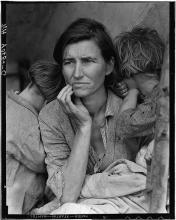The image above is a public domain image from the Library of Congress collection. The photographer is Dorothea Lange. The woman in the 1936 photo is a 32-year old migrant pea-picker named Florence Thompson, shown with three of her seven children. It's part of a series of photos Lange took of migrant mothers. In an article some 24 years later Lange said that
She said that they had been living on frozen vegetables from the surrounding fields, and birds that the children killed. She had just sold the tires from her car to buy food. There she sat in that lean- to tent with her children huddled around her, and seemed to know that my pictures might help her, and so she helped me. There was a sort of equality about it.
We are increasingly preserving these fragile paper and glass and tin images to digital format, where they stand a better chance of long term survival, and a much greater audience. These images serve as historic primary sources that allow us, sometimes centuries later, to remember that history is something that happened to real people with real lives.
In the late 1880s an Italian photographer named Adolfo Farsari was atypically allowed access to Japan beyond the carefully controlled acces to ports and cities and officials to which Europeans were more often restricted. These photographs were then carefully and painstakingly hand-colored. You can read more about these fascinating images, and see them for yourself here.
There's been a number of such archival image collections lately that digital technology and the Web have made it possible for the collections to be shared. I've written here about how French filmmaker Claude Friese-Greene used a special color film process to capture films of London in 1927. A Russian photography name Sergei Mikhailovich Prokudin-Gorskii created a special process of using three images of the same subject, each taken with a color filter, and then combing them the create a color image, in much the same way three color strip films were made. Prokudin-Gorskii traveled throughout Russian taking photographs and developing them in his specially appointed railroad car. The images capture a way of life that even Prokudin_Groskii was aware was almost gone You can see and read about his images here.
There are also a number of public archives online, though many of them do restrict the use of the images, you can browse freely. The Smithsonian has a public archive here. Image sharing service Flickr, a Yahoo subsidiary, has a Flickr Commons area for public archives. Participating institutions include the Library of Congress, the Smithsonian, many universities, and state and national libraries from Australia, Scotland, Wales, France and elsewhere. The restrictions on the images are all clearly posted, if there are any. These collections are fascinating and should be more utilized and known than they are.
